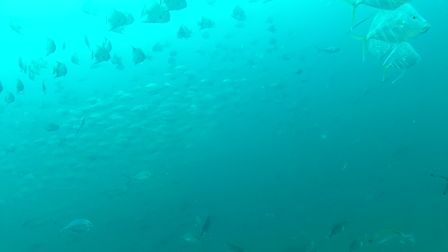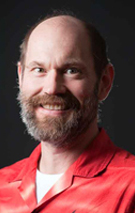Featured Stories | June 12, 2013
Engineering Solutions In Synergy With The Sea
From double-timing artificial reefs to bathroom-inspired oil spill solutions and the best advice post-Fukushima officials ever got, MIT prof. Alexander Slocum is thinking on a level above the rest.
By Genevieve Wanucha
In the 1930s, Dearborn Michigan Sewage Treatment Plant was crippled by the soaring cost of the acid solution they needed to treat raw sludge. Right next door, Ford Motor Company faced an opposing conundrum, forced to pay to dispose of the toxic acid “pickling liquid” they used to finish steel parts. But the outcome of quick thinking after overheard complaints—hauling over barrels of Ford Motor’s acid waste to treat Dearborn’s sewage sludge–was a solution worth $20,000 of savings a year.
This slice of history is one of MIT engineer Prof. Alexander Slocum’s favorite examples of original systems-level thinking. “It’s the motivation of looking at inventions as part of a symbiotic relationship,” he says. Call it synergy. Call it mutual benefit. It happens on Californian farms when imported honeybees finish pollinating the almond trees just as the cherry trees come into bloom. It happens when an airline can fly with just 15 passengers because the empty seats are compensated by packages in the cargo hold. “The idea of symbiotic relationships is used in a lot of places,” he says. “I just think we need to be thinking in a similar way for more ocean systems.” And he has.
SPHERICAL BEACONS OF LIFE
Slocum’s most recent design is the Ocean Renewable Energy System (ORES). The audacious attempt at a clean energy scheme, unveiled in a recent issue of Proceedings of IEEE, comprises a system of enormous concrete spheres that serve as sea-floor storage vessels for excess electricity generated by attached floating wind turbines. What makes the design worth it’s cost is a synergistic relationship with the sea. “There’s this stuff in the ocean. It’s called Life and it grows on everything,” he says. As he implies, these submerged energy storage spheres would quickly colonize with sea life, and with the connections to the surface could become artificial reefs. He hypothesizes that these new “beacons of life” could attract fish and help replenish the collapsed stocks in some New England fisheries.

Wind farms often stir the ire of fisherman, as the structures could get in the way of their boats and trawls or disrupt habitats. But Slocum sees the opposite. “The Gulf of Mexico, for example,” he says, “once worried that offshore oil rigs would have a terrible negative impact on fishing, but the structures themselves became oases in the deep water for ocean life.” With an eye to the details, Slocum believes his wind farm structures could be positioned deep enough to fulfill the temperature and salinity requirements for various life stages of valuable species such as halibut, monkfish, whiting, and pollack.
To people in the artificial reef field, Slocum’s concept is viable. According to reef expert Dan Wilhelmsson, Deputy Director at the Swedish Secretariat for Environmental Earth System Sciences, “There is increasing evidence from Sweden, the Netherlands and Belgium that wind turbines can attract a number of species, sometimes in quite high concentrations. But, only a few studies have been done so far.” There’s precedent for the approach. For instance, the rocky foundations of wind turbines provide an ideal habitat for young lobsters. Biologists at Alfred-Wegener Institute are rearing 3,000 lobsters to be released in the Rifgatt wind park in the German North Sea, hoping to reestablish a lobster population decimated by WWII bombing, Meanwhile, Wilhelmsson is personally monitoring lobsters around a test wave farm off Lysekil on the west coast of Sweden. He reports that citizens and recreational fisheries are now fishing thriving crustacean populations.
The reef concept’s viability ultimately depends on how they are managed. Wilhelmsson notes the plan cannot be simply about making fish easier to catch. “There is always a risk that the fishing pressure from using set nets, cages etc., around the turbines would increase without matching the increase in fish production. But if the area is protected from fishing and used as a refuge and larval source, I see only benefits from a fisheries point of view. It would favor fish stocks.” These natural fish breeding grounds would altogether avoid a major problem with coastal fish farms, which self-pollute as fish swim in their own waste, causing disease and necessitating the use of antibiotics.
For Slocum, the possibility of energy independence depends on synergistic thinking. “Fish farmers don’t necessarily think of offshore wind power people. There is too much individualized, segmented, independent linear thinking going on,” he says. “We want to combine all the different players from all these areas. We want to get more cross-pollination.”
“DUCKS IN A ROW”

Even after Slocum impressed President Obama with a demonstration of the ORES system in his signature Hawaiian shirt, the US government and private venture firms have, as of yet, declined to fund the ORES because of the long-term development period required. Yet, others have seized upon his elegant offshore wind solutions.
Earlier this year, he attended a special conference in Fukushima, Japan at which the officials and researchers were having a hand-wringing trouble of time deciding whether they should build offshore wind farms to replace the energy lost in the 2011 nuclear plant disaster. Slocum stood up and laid out a plan. He acknowledged the Fukushima fishermen’s disapproval of the wind farm idea, but pointed out that commercial fishing is banned in the radiation-contaminated zone anyway. Unemployed fishermen, Slocum suggested, could be paid to help set up the wind turbines, maintain them, and eventually assess whether the wind turbines positively or negatively impact fishing.
Slocum didn’t stop there. He pointed out that Japan has the capacity to manufacture about 12 million automobiles per year, but they are currently only making 8 million cars, leaving a capacity of 4 million autos a year just sitting there. “Put it this way,” he said, “making one offshore wind turbine takes the same amount of industrial might as making 1,000 cars, so even if you used only half of your excess auto capacity to produce wind turbines instead— that’s 2,000 wind turbines in a year.” When he talks math, his logic is irresistible. “Per year, a next generation offshore wind turbine might produce 4 megawatts of power even with a capacity factor of 50-60%. So, one turbine could give you 2 megawatts of power; 2,000 wind turbines will produce 5 gigawatts. In 12 years, you could replace your 50-gigawatt power shortage.” The committee considered: “we never thought of it that way.”
The Fukushima offshore wind project has recently launched. A total of 143 wind turbines will be built 16 km from Fukushima by 2020, with the goal of energy self-sufficiency by 2040. Slocum’s not involved, but the project will always echo his kick.
‘HAIRBALL’
Slocum served as a “design guy” on then Secretary of Energy Chu’s special team working non-stop at full speed to help halt the Gulf Oil Spill of 2010. The long process of proposing and attempting various solutions finally came to an end when BP attached and engaged a ‘sealing cap’ atop the broken blowout preventer, stopping the oil flow. But it was a previous attempt at the ‘junk shot’ that was especially nerve-wracking for Slocum. This method involves attempting to clog the well’s failed blowout preventer with golf balls, tire bits, rope bits, and tennis balls, but it risks creating a pressure spike in the well bore that ruptures the formation, causing a truly unstoppable oil spill. As Slocum watched the junk shot fail to stop the flow, he began to think of the way long hair slowly and inexorably folds its way into clumps thick enough to plug up a bathroom drain.

Back at MIT, Slocum began to envision a “hairball” of wire that could hang out beside an oil rig’s blowout preventer. In the case of a spill, a whirring spool would immediately and rapidly feed wire into the well bore. “Invariably, the wire would grab a hold of something and build up just like hair does in your drain,” he says. When Folkers Rojas, a graduate student in the MIT Precision Engineering Research Group, came looking for a PhD thesis project that would be an applicable engineering challenge, Slocum had an idea ready.
The continuous coiling action of trapped hair or wire is driven by the physical principle of entanglement, i.e., when a body is pushed from behind with nowhere to move forward. Most people try to avoid entanglement at all costs, for example, when pumping out ropes of red-hot metal, deploying fishing nets and equipment, or laying down communication lines in the ocean floor. “So, there hasn’t been an application where they’ve needed to know exactly how entanglement works,” Rojas says. “Most run away from it; I’m trying to create it.” He must find the optimal conditions under which wire will tangle into an impenetrable mass in an onslaught of flowing oil. And they will be exceedingly specific. “There is a sweet spot having to do with the oil velocity, well-bore diameter, and wire volume,” he says. To find this goldilock’s zone, he works with an experimental set up in the lab and mathematically models the wire’s behavior. Rojas and Slocum, his adviser, have already filed a patent and secured the interests of oil companies.
Slocum mentors Rojas “on the run”—literally meaning that they troubleshoot the wire invention while running long distances, pedaling uphill, or training for Ironman triathlons. This practice reflects Slocum’s fundamental belief that intense exercise (“aerobic activity for periods longer than one hour”) energizes the mind as much as the body. Before Rojas joined Slocum’s lab, he had never run more than two miles. Now, he easily runs ten and can vouch for the mental power his adviser ascribes to pushing one’s body past its farthest limit. It makes perfect symbiotic sense, brainstorming when the brain is on fire.






